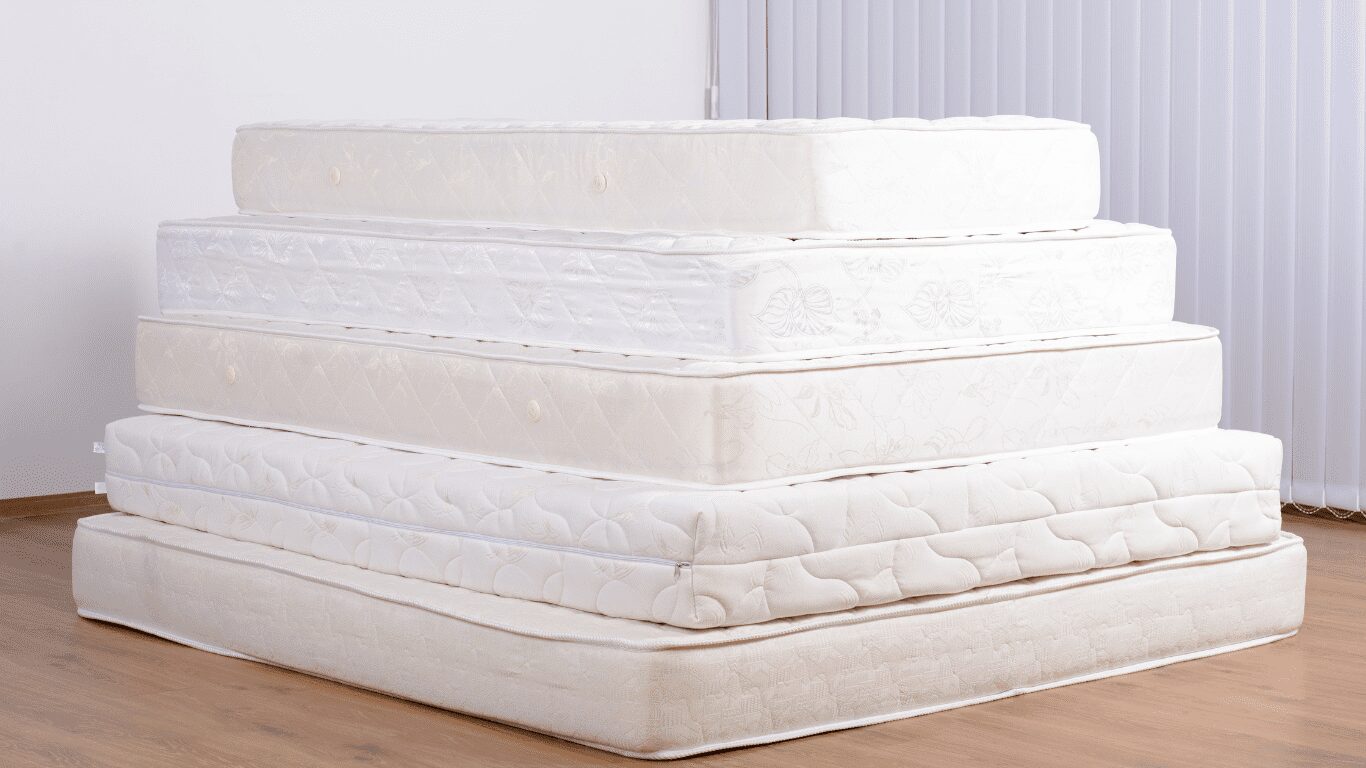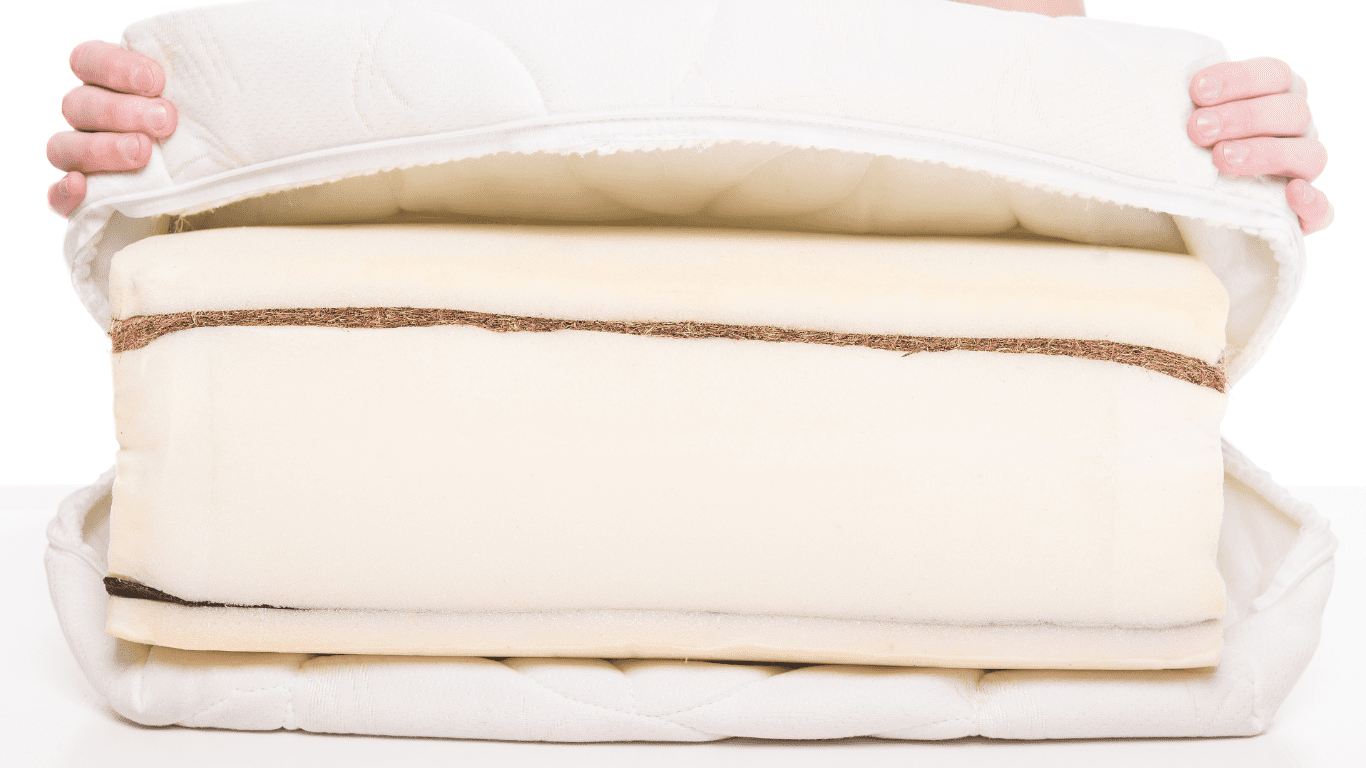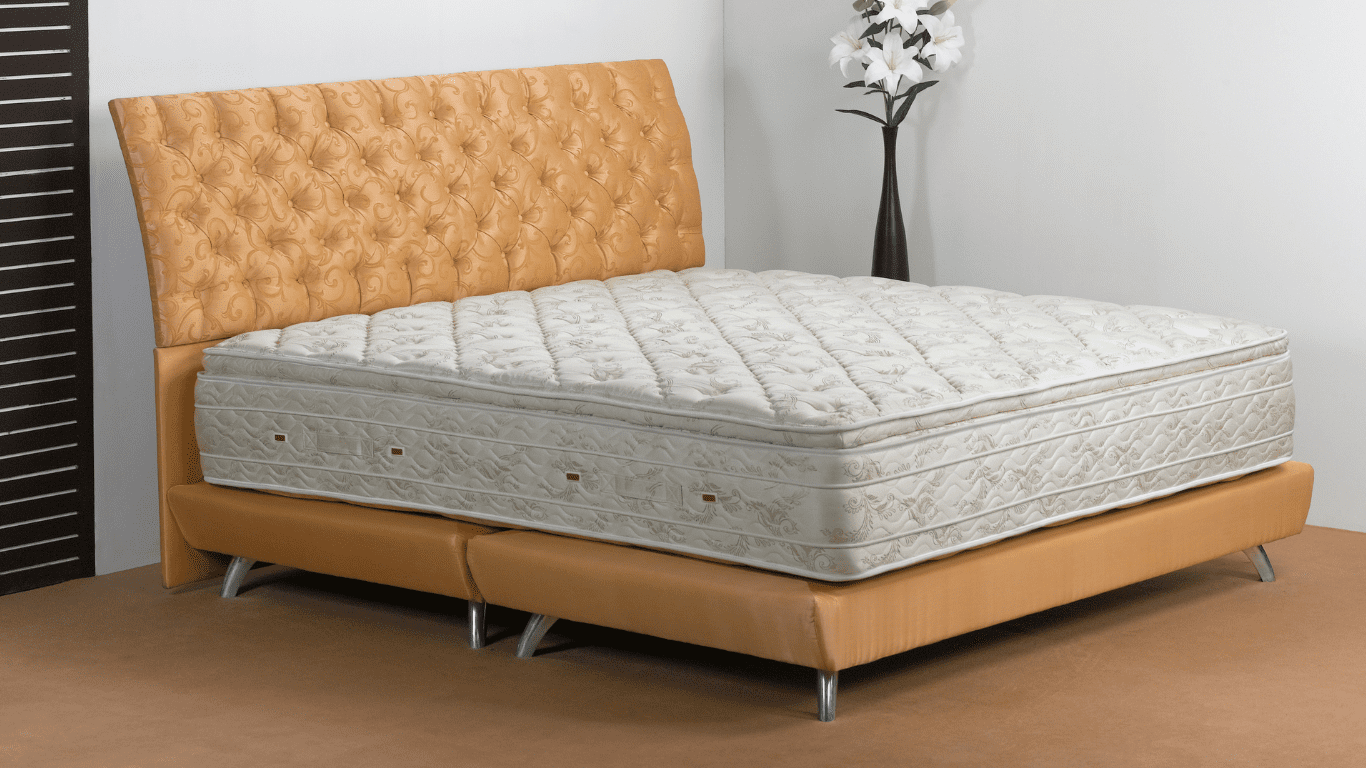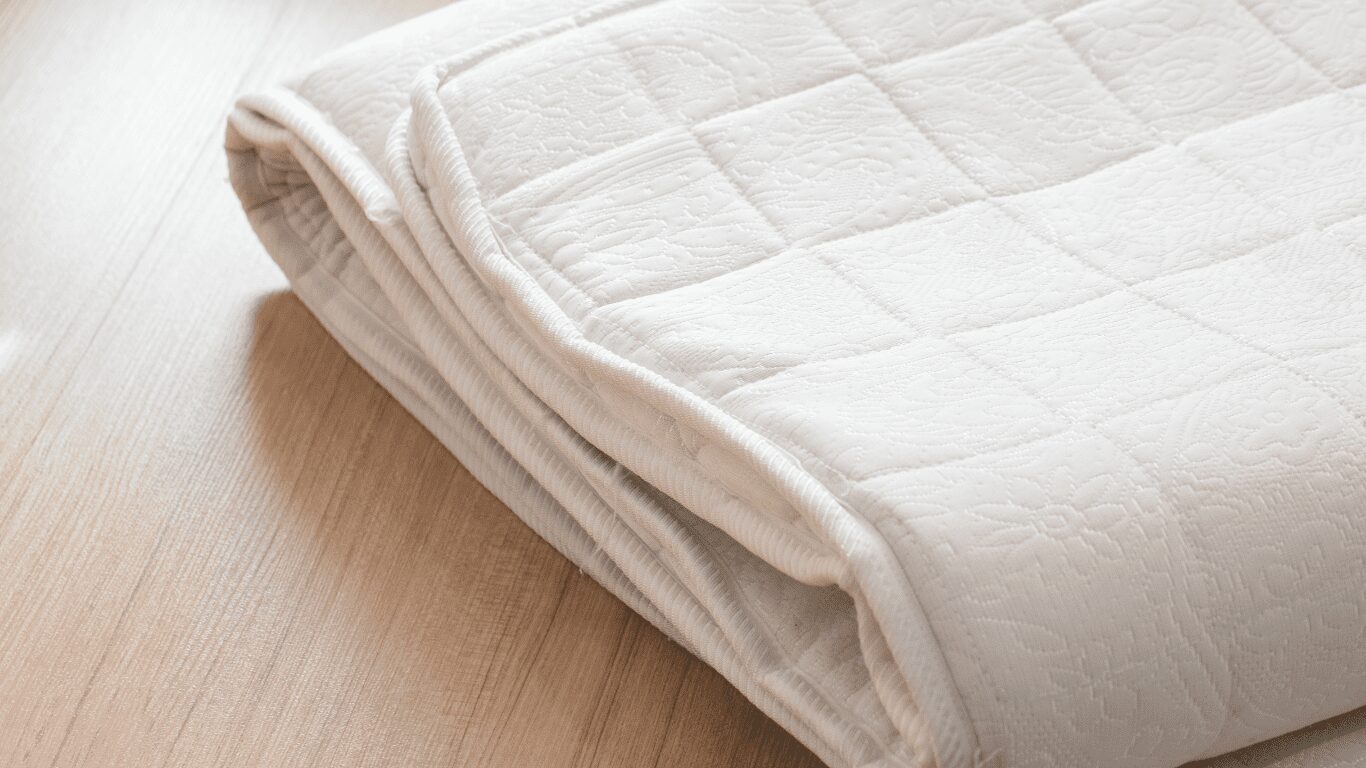The Comprehensive Guide to Choosing the Perfect Mattress
Sleep is an integral part of our lives. And the mattress we sleep on significantly influences the quality of our sleep. Today, the market is flooded with various types of mattresses, which can be quite overwhelming. To help you navigate through this maze and make an informed decision, we have prepared a comprehensive guide to help you understand the different types of mattresses, their strengths and weaknesses, and tips on choosing the best mattress for your needs.
Different Types of Mattresses
1.Spring Mattresses

Spring mattresses, also known as innerspring or coil mattresses, are among the oldest and most popular types of mattresses on the market. They use a system of metal coils or springs to provide support, with layers of padding and upholstery for comfort. There are four primary types of coil systems: Continuous Coil, Bonnell, Offset, and Marshall/Pocketed Coil.
- Continuous Coil
A continuous coil mattress is constructed from a single, continuous piece of wire shaped into rows of springs. These rows are then attached to one another using helical wires. This interconnected design creates a strong, durable mattress structure. The continuous coil system is known for its excellent support and durability at a lower price point, making it a popular choice for budget-conscious consumers. However, because all the coils are connected, they tend to transfer motion more significantly than other types of spring systems, which can be a concern for people sharing the bed.
- Pros: Generally less expensive; durable; offers even support.
- Cons: Motion transfer can be significant; not optimal for pressure point relief.
- Key Features: Designed with a single, continuous wire shaped into springs, interconnected for robust support and durability.
- Bonnell
The Bonnell coil system is the oldest and most traditional type of innerspring mattress system, dating back to the early 19th century. The coils are hourglass-shaped and interconnected with helical wire. This system offers robust support and durability. Bonnell coils are typically found in budget-friendly and mid-range mattresses, making them a popular choice for children's beds and guest rooms. Like continuous coil mattresses, Bonnell coil mattresses can also be prone to significant motion transfer.
- Pros: Economical; durable; provides firm support.
- Cons: Not ideal for reducing motion transfer; can be noisy.
- Key Features: Features an hourglass-shaped steel spring system, often used in traditional innerspring mattresses.
- Offset
Offset coil mattresses are designed with squared-off tops or bottoms on the coils, allowing them to conform more closely to the body's shape. These are interconnected with helical wires, creating a hinged effect that adapts to body weight and shape. Offset coils offer a good balance between contouring and motion isolation. They are typically found in higher-end mattresses due to their increased conforming ability, which provides more significant pressure relief.
- Pros: Great body contouring; reduced motion transfer compared to other spring types.
- Cons: Pricier than other spring mattresses; potential for springs to degrade over time.
- Key Features: Similar to Bonnell coils, but with squared-off tops to create a more body-conforming surface.
- Marshall/Pocketed Coil
Also known as pocketed or encased coils, Marshall coils are thin-gauge, barrel-shaped coils that are individually wrapped in fabric pockets. This design allows each coil to respond independently to pressure, providing excellent motion isolation and precise contouring to the body. Pocketed coil systems are usually used in luxury and hybrid mattresses due to their superior comfort and support. They are typically more expensive than other types of spring systems, but many people find the enhanced comfort and minimized motion transfer to be worth the extra cost.
- Pros: Excellent motion isolation; provides good body contouring.
- Cons: Higher price point; some models may lack edge support.
- Key Features: Springs are individually wrapped in fabric pockets, allowing each to move independently.
Each of these spring systems has its own unique set of advantages and potential drawbacks. The right one for you depends on your budget, sleep style, comfort preferences, and whether or not you share your bed with a partner. Regardless of the type, spring mattresses are known for their durability and support, making them a reliable choice for many sleepers.
2. Foam Mattresses
Foam mattresses are increasingly popular due to their innovative design, superior comfort, and support. These mattresses are made entirely from foam, though different types of foam may be used in various layers for comfort, support, and cooling. Let's take a closer look at some of the most common types of foam used in these mattresses.

- Memory Foam
Memory foam is a high-density, viscoelastic polyurethane foam that softens in response to heat and pressure, allowing it to contour closely to the body. This excellent contouring ability makes memory foam great at relieving pressure points and aligning the spine, which can help reduce back and joint pain. However, traditional memory foam tends to trap heat and can create a "sinking" feeling that some sleepers don't like.
- Pros: Excellent pressure point relief; good motion isolation.
- Cons: Can trap heat; may lack robust edge support; can have an initial off-gassing smell.
- Key Features: Uses viscoelastic foam that molds to the body in response to heat and pressure.
- Gel or Gel-Infused Foam
To combat the heat retention of traditional memory foam, manufacturers developed gel or gel-infused memory foam. This type of foam incorporates cooling gel particles or liquid gel into the memory foam to help dissipate heat and keep sleepers cooler throughout the night. Gel-infused foam maintains the contouring and pressure-relieving benefits of traditional memory foam while providing a cooler sleep surface.
- Pros: Good pressure relief; cooler than traditional memory foam.
- Cons: May lack firmness over time; higher price point.
- Key Features: Memory foam infused with gel beads that can absorb and disperse body heat.
- Latex
Latex is a type of foam made from the sap of the rubber tree. It's known for being durable, breathable, and responsive. There are two primary types of latex: Dunlop and Talalay.
1.Dunlop: Dunlop latex is dense and durable, with a heavier bottom that makes it excellent for support layers in a mattress. The production process for Dunlop latex is simpler and more energy-efficient, which often makes it less expensive than Talalay latex.
- Pros: Durable; good support; more "green" as it can be made from natural latex.
- Cons: Can be heavy; less consistent texture with potentially more firmness at the bottom.
- Key Features: Latex is poured in one complete pour, making it denser and heavier.
2.Talalay: Talalay latex goes through a more complex production process that results in a more consistent, lighter, and softer feel. This makes it great for comfort layers in a mattress. It is generally more expensive than Dunlop latex.
- Pros: Consistent, soft texture; good pressure relief; durable.
- Cons: Expensive; may lack the support of Dunlop.
- Key Features: Latex is poured in stages, creating a consistent, light, and fluffy texture.
- Polyfoam
Polyfoam, or polyurethane foam, is a common material used in all-foam and hybrid mattresses. It's less expensive to produce than memory foam or latex, making it a popular choice for budget-friendly mattresses. While it can offer good comfort and support, polyfoam tends to be less durable and may break down more quickly than other types of foam.
- Pros: Affordable; can offer good comfort and support.
- Cons: Less durable than latex or memory foam; can degrade quickly.
- Key Features: Made from polymers of polyurethane, can range from soft to firm.
- Orthopaedic Memory Foam Mattress
Orthopaedic memory foam mattresses are specially designed to support the joints, back, and overall body. They are generally made with high-density memory foam that conforms closely to the body to provide optimal spinal alignment and pressure relief. Orthopaedic memory foam mattresses can be an excellent choice for people with back pain, arthritis, and other joint or muscle issues.
- Pros: Designed for optimal support and comfort; can help with alignment and pain relief.
- Cons: Can be expensive; may feel too firm for some sleepers.
- Key Features: Specifically designed to support joint, back, and overall body health.
- Bonded Foam Mattress
Bonded foam mattresses are made from scraps of foam that are bonded together under high pressure. The result is a highly dense and firm mattress that provides excellent support. These mattresses are often used in orthopaedic designs and are known for their durability. However, they may not offer as much contouring or pressure relief as other types of foam.
- Pros: Durable; firm support; relatively affordable.
- Cons: Can be too firm for some sleepers; lack of plushness.
- Key Features: Made from scraps of various high-density foams that are bonded together under pressure.
In summary, the type of foam mattress that will be the best fit for you depends on a variety of factors, including your budget, your comfort preferences, any pain or pressure points you experience while sleeping, and your preferred sleeping temperature. Each type of foam has its own unique set of benefits and potential drawbacks to consider.
3.Hybrid Mattress

Hybrid mattresses combine the best elements of different mattress types, typically pairing an innerspring coil support system with a layer of comfort foam or memory foam. This fusion offers the pressure-relieving benefits of foam with the support and airflow of traditional spring mattresses. Hybrid mattresses are an ideal choice for those who prefer the bouncy feel of an innerspring mattress but also want the comfort and support of foam.
- Pros: Combines benefits of foam and spring mattresses; good pressure relief and support.
- Cons: Can be expensive; may be heavy and difficult to move.
- Key Features: Combines innerspring coils for support and foam layers for comfort and pressure relief.
4.Dual Comfort Mattress

Dual comfort mattresses are designed to accommodate different comfort preferences in a single mattress. They're typically split down the middle, offering two separate firmness levels. This is ideal for couples who have different sleep preferences, for example, one person might prefer a soft mattress while the other prefers a firmer surface. Dual comfort mattresses ensure that both individuals get a personalized sleep experience without compromise.
- Pros: Offers different firmness on each side; customizable.
- Cons: The difference in sides can create a noticeable "split" in the middle.
- Key Features: Allows sleepers to choose different firmness levels for each side of the bed.
5.Alternative Mattress Types
Adjustable Bed Mattresses: These mattresses are designed specifically for adjustable beds, which can be manipulated to elevate the upper or lower body. They are usually made from flexible materials like latex or memory foam to accommodate the movement of the bed base.
- Pros: Can be adjusted for personal comfort; potential health benefits like reduced snoring or back pain.
- Cons: Expensive; mechanical issues possible over time.
- Key Features: Designed to work with adjustable bed bases.
Futon: Futons are a type of low-profile mattress that can double as seating. Originally from Japan, futons are traditionally made from layers of cotton, but modern versions may also incorporate foam or innerspring coils for added support and comfort.

- Pros: Space-saving; versatile; affordable.
- Cons: Can be less comfortable than traditional mattresses; lack of support.
- Key Features: Doubles as a sofa and a bed.
Waterbed: Waterbeds use water as the primary support system and are encased in a resilient material to prevent leakage. They offer a unique, floating sleep experience and can be heated for added comfort. However, they require regular maintenance and can be heavy and difficult to move.

- Pros: Can be heated; offers a unique floating sleep experience.
- Cons: High maintenance; potential for leaks; lacks firm support.
- Key Features: Uses water as a primary support system.
Air Mattress: Air mattresses are inflated to provide a sleeping surface, offering customizable firmness levels. They are ideal for temporary or guest sleeping solutions, but high-end models are suitable for regular use.
- Pros: Customizable firmness; easy to store and transport.
- Cons: May not be durable enough for long-term use; can lose air and sag.
- Key Features: Uses air as the primary means of support.
Pillowtop: Pillowtop mattresses feature a soft layer stitched on top of the mattress core. This layer, filled with materials like cotton, wool, latex, or foam, provides a plush sleeping surface that can relieve pressure points.
- Pros: Provides a plush, soft surface; good pressure relief.
- Cons: Can compress over time; may sleep hot.
- Key Features: Extra layer stitched on top of the mattress core for added comfort.
Organic: Organic mattresses are made from materials grown and processed without synthetic fertilizers, pesticides, or other chemicals. These can include organic cotton, wool, latex, or other sustainably sourced materials. They're a popular choice for those seeking an eco-friendly and hypoallergenic sleeping environment.
- Pros: Environmentally friendly; good for allergies and sensitivities.
- Cons: Expensive; certifications can be confusing.
- Key Features: Made from organic and natural materials.
Smart Mattress: Smart mattresses incorporate technology for a personalized sleep experience. Features can include sleep tracking, temperature regulation, adjustable firmness, and even connectivity with other smart home devices. Though more expensive, they're an excellent investment for tech enthusiasts and those looking to optimize their sleep quality.
- Pros: Advanced features for personalization; can improve sleep quality.
- Cons: Very expensive; can have a learning curve.
- Key Features: Incorporates technology like sleep tracking, temperature regulation, and connectivity with smart devices.
What Factors to Consider When Selecting a Mattress
Choosing the right mattress is an important decision, given the significant impact it can have on your overall health and quality of life. When looking to purchase a new mattress, the following are some of the key factors to consider:
1. Comfort and Personal Preference:
Comfort should always be a priority when shopping for a mattress. Your personal preference regarding the firmness level, size, and type of mattress material can greatly affect your sleep quality. Some people prefer a soft, plush mattress while others require a firmer surface.
2. Size of the Mattress:
Select a mattress size that suits your needs. Mattress sizes range from single or twin size to king or even California king. Factors such as your height, if you sleep alone or with a partner, and the size of your bedroom can all influence this decision.
3. Type of Mattress:
As detailed in the previous sections, there are many types of mattresses available, including innerspring, foam, hybrid, and alternative types like air mattresses or waterbeds. Each type offers unique benefits and drawbacks, so consider which qualities are most important to you.
4. Firmness Level:
The firmness level of a mattress is often related to your comfort and how well the mattress can support your body. This can significantly impact your sleep quality, especially if you have any back or joint issues. Firmness is often subjective and can vary between different brands and models.
5. Sleep Position:
Your preferred sleep position can also affect what type of mattress and firmness level is best for you. Side sleepers often need a softer mattress that can contour to their body's curves, while stomach sleepers usually require a firmer mattress. Back sleepers typically fall somewhere in the middle.
6. Budget:
Mattresses can vary greatly in price. Establish your budget before shopping, but remember that a mattress is a long-term investment in your sleep and overall health.
7. Lifespan and Durability:
Investigate the lifespan and durability of the mattress. A quality mattress should last you between seven to ten years. Reviews, warranties, and the reputation of the brand can help indicate the longevity of the product.
8. Temperature Regulation:
Some mattresses, especially those made of foam, can retain heat, which might disturb your sleep. If you tend to sleep hot, consider a mattress with good temperature regulation features, such as gel-infused memory foam or innerspring mattresses.
9. Trial Period and Warranty:
Many mattress companies offer a trial period during which you can test the mattress. This can be incredibly helpful to ensure it's the right fit for you. Additionally, consider the warranty provided. A longer warranty might indicate higher confidence from the manufacturer in their product.
10. Health Considerations:
If you have specific health issues such as back pain, allergies, or sleep apnea, these should also influence your choice. Some mattresses are designed with specific health benefits in mind, such as orthopedic mattresses for back pain or hypoallergenic materials for allergy sufferers.
11. Eco-Friendliness:
If sustainability is important to you, consider an organic or eco-friendly mattress. These are made with natural materials and are usually free of harmful chemicals.
Remember, it's essential to invest time in researching and trying out different mattresses. After all, you'll be spending a significant portion of your life sleeping on it, so it's crucial to make an informed decision.
Which Type of Mattress Is Best?
The "best" type of mattress can greatly vary from person to person and is largely dependent on individual preferences, body type, sleeping habits, and any specific health considerations. That said, it's important to note some general trends:
For Sleepers with Chronic Pain: Memory foam and latex mattresses are often recommended for individuals with chronic pain, particularly back pain, because they offer a good balance of comfort and support. Orthopedic mattresses are also designed specifically for this purpose.
For Hot Sleepers: If you tend to sleep hot, innerspring and hybrid mattresses are generally better options as they provide more airflow compared to traditional foam mattresses. Gel-infused foam mattresses can also help dissipate heat.
For Allergy Sufferers: Latex and memory foam mattresses are resistant to dust mites and molds, common allergens found in many homes. An organic mattress is also a good choice as it's typically hypoallergenic.
For Couples: Hybrid mattresses and pocketed coil mattresses are ideal for couples because they provide excellent motion isolation, meaning one person's movement won't disturb the other person's sleep.
What Is the Most Common Type of Mattress?
As of my knowledge cutoff in 2021, the most common type of mattress in many parts of the world, particularly in the United States, is the innerspring or coil mattress. These mattresses are popular because they offer a traditional feel, good support, and typically come at a lower price point compared to other types of mattresses. However, memory foam mattresses and hybrids are rapidly growing in popularity due to their combination of comfort, support, and pressure relief.
Mattresses You Definitely Want to Avoid Buying
While the "right" mattress can be subjective, there are certain types of mattresses or shopping practices you should avoid:
Cheap Mattresses with Low-Quality Materials: These mattresses may be enticing due to their low price, but they often wear out quickly, don't offer proper support, and may even contain harmful chemicals.
Mattresses without a Trial Period: Given the investment involved, it's advisable to avoid purchasing a mattress that doesn't offer a trial period. This is especially important when buying online, as you can't test the mattress beforehand.
Mattresses with a Short or Nonexistent Warranty: A mattress is a significant investment and should come with a substantial warranty period that protects against manufacturing defects.
Non-Certified Foam Mattresses: Look for mattresses with certified foam, such as CertiPUR-US or Oeko-Tex, which ensure that the foam is free of harmful chemicals and has low VOC emissions.
Used Mattresses: Buying used mattresses is not recommended for hygiene reasons, and because you can't accurately gauge their remaining lifespan or their past care.
One-Size-Fits-All Claims: Be wary of brands claiming their mattress is perfect for everyone. Different people have different sleep needs, and what's comfortable and supportive for one person may not be for another.
Always remember to do your research before purchasing a mattress. Read reviews, compare brands, and take advantage of trial periods to ensure you're getting the best mattress for your personal needs.
Conclusion
Choosing a mattress can be a complex process given the array of options available today. The key to finding the perfect mattress lies in understanding your unique sleep needs, personal preferences, and the distinct characteristics of each mattress type. Be it a spring, foam, hybrid, or an alternative mattress type, each comes with its own set of advantages and potential drawbacks. Always prioritize quality over price and don't rush the buying process. Remember, a good mattress is a sound investment in your health and well-being, and with proper care and maintenance, it should serve you well for many years to come.
FAQ’s
Q: How often should I replace my mattress? A: On average, a good quality mattress should last about 7-10 years. However, if you're experiencing discomfort or poor sleep quality, it might be time to consider a replacement.
Q: Can I use my new mattress immediately after unboxing? A: Some mattresses, particularly those that are bed-in-a-box, may need 24-48 hours to fully expand and air out after unboxing.
Q: What's the difference between a mattress topper and a mattress pad? A: A mattress topper is typically thicker and provides additional comfort and support. A mattress pad is thinner and primarily used for protection against spills, stains, and wear and tear.
Q: Is a firm mattress always better for back pain? A: Not necessarily. The best mattress for back pain depends on your sleeping position and personal comfort preferences. A medium-firm mattress can often provide a good balance of support and pressure relief for back pain sufferers.
Q: How can I dispose of my old mattress?
Q: What is mattress off-gassing?
A: You can donate it to a local charity, recycle it, or see if the retailer you’re buying your new mattress from offers a removal service. Check local regulations, as some areas have specific rules for mattress disposal.
A: Off-gassing refers to the release of a chemical smell from a new mattress, particularly those made with synthetic materials. It usually dissipates within a few days and can be minimized by airing out the mattress in a well-ventilated room.
Remember, when it comes to selecting a mattress, personal comfort is the ultimate guide. If possible, try out different types of mattresses in a store or take advantage of home trials to find what suits you best.



